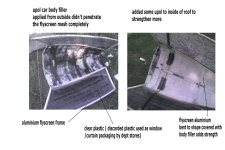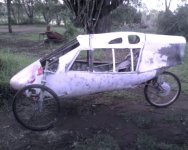I did one side using some fibreglass resin over the flyscreen mesh initially, but didnt' have very much resin only a very small tin ( 250ml) of it, but I found that just letting the resin run down with gravity, it tends to run in lines, instead of trying to smooth it over a large surface I sort of let it run, those runs gave quite a bit of strength. Then a thin layer of upol is very much adequate strength, the other side was done just with the upol and flyscreen, strength is still ok but not as good as where there are some runs of fibreglass included ( hope makes sense).
Upol is a car body filler, a 4litre tin weights 3kg, in australia a 4 litre tin costs $33aud ( extremely cheap), its made in the uk so should be readily available over there. I found it while searching the net for alternatives to fibreglass, there were some ebay sellers but I found a local supplier was much cheaper way to get it.
Its an extremely labour intensive way to make a fairing, but also low cost, many many hours taken to do it this way, I've just been sanding back the upol to get a smooth finish, also very time consuming but results are looking very good. Its certainly a very rigid fairing and light weight, the downside is the time involved to do it. The aluminium mesh takes a long time to put in place, well took me a long time, could no doubt quicken the process if I do another fairing, is a bit of a learning curve as I go along. The mesh really makes alot of difference to the strength of the upol, a bit like reinforced concrete i guess.............but lighter. Ideally fibreglass and carbon fibre mesh would be the ideal way to go, but very expensive option, pretty happy with the results using this method.
As a way to try explain the strength of the fairing, its extremely rigid, theres no noticeable flex in it, I can hit the sides hard with an open palm without damaging it, a hard hit with a closed fist would likely cause cracking ( not that i'm going to try it), would certainly withstand windflow at highspeeds no problems, I doubt stones flying up from say a passing car would do any damage. If involved in an accident I dont think the fairing would be much use.



